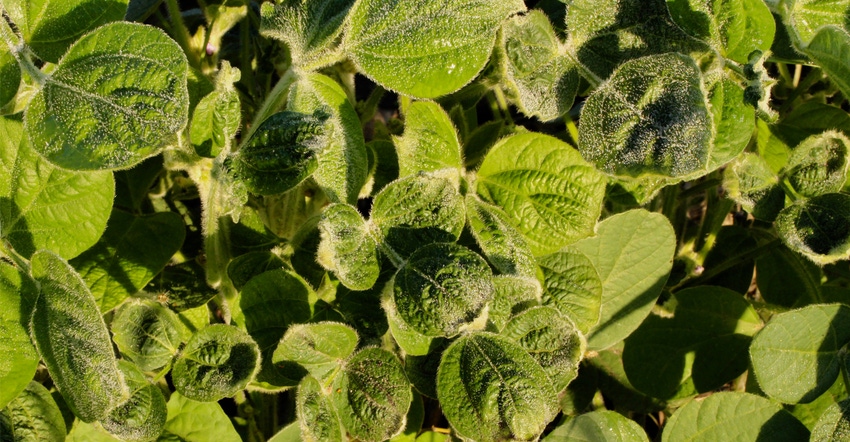
The U.S. Environmental Protection Agency in October announced changes to the new dicamba herbicide product labels in response to widespread off-target plant injury in 2017.
The most significant change is classification of the new dicamba formulations as restricted-use products. Other changes will reduce the hours available to spray dicamba-resistant soybeans with the weed killer.
The label changes include:
• restricting applications to between sunrise and sunset
• reducing the maximum wind speed during application from 15 to 10 mph
The ability to cover all of the acres that need to be sprayed in a timely manner has always been an issue, and these new limits will add to that difficulty, say Iowa State University Extension weed management specialists.
The new dicamba herbicide products that are now “restricted use” are only Xtendimax, Engenia and FeXapan. Other (older) dicamba products (Banvel, Clarity, Marksman, Northstar, Pulsar, Rave, Require Q, Status, Yukon, etc.) are not restricted use. Of course, only Xtendimax, Engenia and FeXapan can be used on dicamba-resistant soybean varieties.
Fewer hours to apply dicamba
A previous article by ISU’s Bob Hartzler and Meaghan Anderson published on the Integrated Crop Management website described the hours available to apply herbicides using restrictions on the first Xtendimax with Vapor Grip Technology label. In updating that previous article, box plot drawings were used to illustrate the distribution of available hours for spraying during two seven-day periods at different times in the growing season. Weather records for four different years were used, providing 28 days in each analysis. Weather data from the ISU Research Farm near Boone was used.
In the updated drawing, New Dicamba Labels Limit Application Timing, the first bar plot of each time period shows hours with average wind speed between 3 and 10 mph during daylight hours. If there was a time frame where winds were within the allowed wind speeds for a single hour, that time was not included in the calculation. The second plot takes into consideration rainfall, subjectively determining how long the rain would keep a sprayer out of the field.
Hartzler and Anderson made the following observations and conclusions, as they interpreted what this drawing shows regarding time available for spraying, as specified by the new dicamba label.
Limited time to complete timely spraying
Wind speeds in Iowa are significantly higher in May than in June, as the drawing shows. When not considering rain, the average hours to spray was about five hours per day in late May, compared to nine hours in mid-June. In late May, half of the days were totally lost for spraying based on wind and rain restrictions. As with wind, rain was a bigger factor in limiting spray hours in May than in June.
While the analysis was conducted with the new dicamba labels in mind, the graphs clearly show the pressure that applicators are under to complete timely spraying of fields, regardless of herbicide, says Hartzler. This is one of the many benefits of preemergence herbicides, spreading out the window for postemergence applications. While applications later in the season provide more hours to complete spraying, temperatures are higher, increasing the risk of volatilization of dicamba.
Be aware of other dicamba label restrictions
Farmers interested in using dicamba as part of their weed control strategy in 2018 need to be aware of all the new label restrictions, says Hartzler.
First, only applicators who are certified to apply a restricted-use product, or the people who work under their direct supervision, will be allowed to apply dicamba. The label change reflects an agreement between EPA, Monsanto, BASF and DuPont on measures to further minimize potential for drift damage to neighboring crops from using dicamba formulations to control weeds. Dicamba can only be used in genetically modified soybean varieties resistant to this herbicide.
EPA worked cooperatively with states, land-grant universities and pesticide manufacturers to examine the underlying causes of recent crop damage. The makers of the new dicamba formulations voluntarily agreed to the label changes that impose additional requirements for postemergence use of these products in 2018, including:
• classifying the products as “restricted use,” permitting only certified applicators with special training and those under the supervision of certified applicators, to apply them
• dicamba-specific training required for all certified applicators to reinforce proper use
• requiring farmers to maintain specific records regarding use of these products to improve compliance with label restrictions
• limiting applications to when maximum wind speeds are below 10 mph (previously from 15 mph) to reduce potential for spray drift
• reducing times during the day when applications can be made
• including tank cleanout language to prevent cross-contamination
• enhancing susceptible crop language and record keeping with sensitive crop registries to increase awareness of risk to nearby crops that are especially sensitive to dicamba. For more information, visit EPA.
About the Author(s)
You May Also Like




